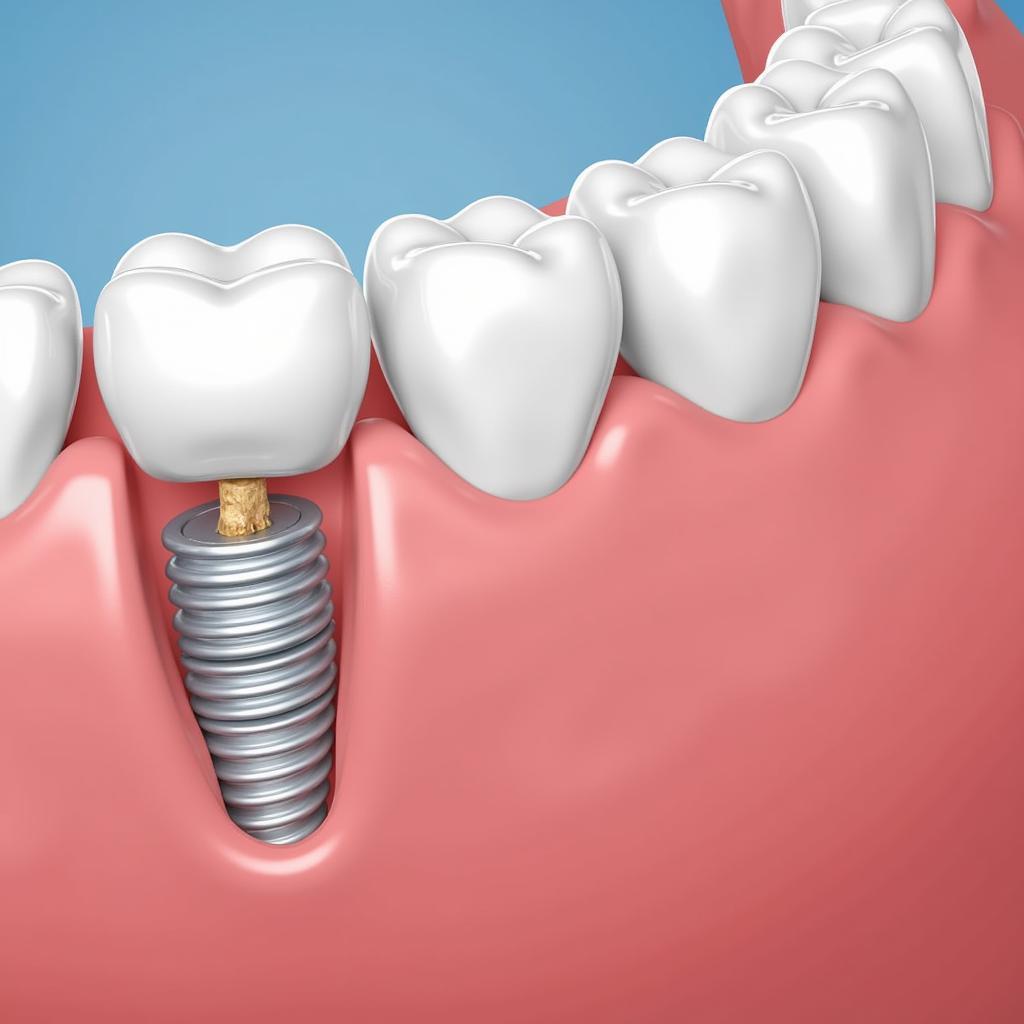Does Food Get Under Dental Implants? It’s a common question for those considering or already enjoying the benefits of this permanent tooth replacement option. While dental implants offer a secure and natural-feeling solution, understanding how they interact with food is essential for long-term oral health and comfort.
Understanding Dental Implants and Food Impaction
Dental implants are designed to mimic the structure of natural teeth, with a titanium post acting as the root, an abutment connecting the post to the crown, and a crown replicating the visible part of the tooth. The fit of these components and the health of the surrounding gum tissue play a significant role in preventing food impaction. Properly placed and well-maintained implants typically have a minimal gap between the crown and the gum, reducing the likelihood of food particles getting trapped. However, factors like implant design, individual anatomy, and oral hygiene practices can influence the risk of food impaction.
 Food trapped under dental implant
Food trapped under dental implant
One common concern is whether food gets stuck under all on 4 dental implants. All-on-4 is a specific technique using four implants to support a full arch of teeth. While the principles of food impaction remain the same, the design of the prosthesis and the slightly different placement of the implants can influence how food interacts with the restoration.
Factors Affecting Food Impaction Under Implants
Several factors can contribute to food getting lodged around dental implants:
- Implant Design: The shape and size of the implant crown, as well as the precision of its fit, can affect food impaction. Ill-fitting crowns or those with improper contours can create spaces where food can easily become trapped.
- Gum Health: Healthy gums are crucial for a tight seal around the implant. Gum disease can lead to pockets around the implant, increasing the risk of food impaction and infection.
- Oral Hygiene: Diligent oral hygiene practices, including brushing, flossing, and using interdental brushes, are essential to remove food particles and prevent buildup around implants.
- Food Choices: Sticky or fibrous foods are more likely to get caught around implants. Being mindful of your diet can help minimize the risk of food impaction.
 Proper dental implant cleaning techniques
Proper dental implant cleaning techniques
How to Prevent and Manage Food Impaction
Regular dental checkups are vital for monitoring the health of your implants and identifying any potential issues early on. Your dentist can assess the fit of your crowns, evaluate your gum health, and provide personalized guidance on oral hygiene techniques.
“Maintaining excellent oral hygiene is paramount for the long-term success of dental implants,” says Dr. Emily Carter, DDS, a leading implantologist. “Regular cleaning removes food debris, preventing inflammation and infection, which can compromise the stability of the implants.”
If you experience food impaction, careful cleaning is crucial. Using tools like interdental brushes, water flossers, or specialized floss designed for implants can help dislodge trapped particles without damaging the restoration.
does food get stuck under all on 4 dental implants
“Patients should avoid using sharp objects or excessive force when cleaning around implants,” advises Dr. Michael Stevens, DMD, a periodontist specializing in implant care. “Gentle but thorough cleaning is key to preventing damage and maintaining the integrity of the implant and surrounding tissues.”
Does Food Get Stuck Under All On 4 Dental Implants? Addressing Specific Concerns
While the general principles of food impaction apply to all types of implants, including All-on-4, certain considerations are unique to this procedure. The design of the All-on-4 prosthesis, which often involves a fixed bridge supported by four implants, can create specific areas where food may become trapped. Regular professional cleanings and diligent home care are crucial for managing these challenges.
Conclusion
Does food get under dental implants? While it’s a possibility, proper implant placement, diligent oral hygiene, and regular dental checkups can minimize the risk and ensure the long-term success of your implants. By understanding the factors that contribute to food impaction and adopting appropriate preventative measures, you can enjoy the benefits of a healthy, confident smile with your dental implants.
FAQ
- How often should I clean my dental implants? Twice daily brushing and daily flossing are essential.
- What type of floss is best for dental implants? Specialized implant floss or interdental brushes are recommended.
- Can food impaction damage my dental implants? Over time, it can lead to inflammation and potentially compromise the implant’s stability.
- What should I do if food gets stuck under my implant? Gently try to remove it with an interdental brush or water flosser. If unsuccessful, contact your dentist.
- Are there certain foods I should avoid with dental implants? Extremely sticky or hard foods can pose a greater risk of impaction.
- Is food impaction more common with certain types of implants? Factors like implant design and individual anatomy can influence the risk.
- How can I tell if I have food impaction under my implant? Discomfort, inflammation, or a bad taste in your mouth could be signs of food impaction.
Situations with potential food impaction around implants:
- Eating sticky or fibrous foods: Foods like caramel, taffy, and certain fruits and vegetables can easily get caught around implants.
- Improper oral hygiene: Inadequate brushing and flossing can allow food particles to accumulate and become trapped.
- Ill-fitting dental crowns: Crowns that don’t fit properly create spaces where food can lodge.
- Gum disease: Inflamed or receding gums create pockets around implants, making them susceptible to food impaction.
Further Questions & Resources:
- Are you concerned about the cost of dental implants? Explore our detailed pricing guide.
- Want to learn more about All-on-4 implants? Read our comprehensive article on this innovative procedure.
Need assistance? Contact us at Phone Number: 02437655121, Email: minacones@gmail.com Or visit our address: 3PGH+8R9, ĐT70A, thôn Trung, Bắc Từ Liêm, Hà Nội, Việt Nam. We have a 24/7 customer service team.